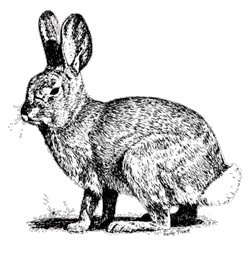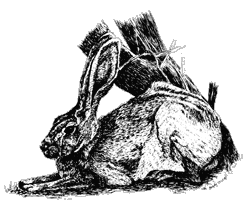Rabbits and Hares
Of all the desert-dwelling mammals, the desert cottontail is probably the one you will see most frequently. Preyed upon by everything from snakes to coyotes to owls, most cottontails are killed within their first year. These rabbits have few defenses other than good eyesight, good hearing, and the ability to flee quickly. They compensate for heavy losses by reproducing at a prodigious rate. Female cottontails can breed at 3 months of age and have multiple litters in a year. Young stay at the nest for only about 2 weeks before venturing off. These reinforcements make for a fairly constant supply of cottontails.

|
Jack “rabbits” —they are actually hares— live in open areas with little cover; they rely on exceptional speed and great leaping ability to evade predators, but they also suffer predative losses.
In the field, size is an easy way to tell cottontails apart from jackrabbits. Cottontails are small, 1 to 2 pound (.45 to .9 kg) animals, while jacks are quite large, weighing up to 10 pounds (4.5 kg) and standing just under 2 feet (.6m) tall. Cottontail babies (true rabbits) are born blind, naked, and helpless; but jackrabbit young (like all young of true hares) are born furred and with their eyes open; they can move around just a few hours after birth.
—Pinau MerlinSonoran Desert species:
desert cottontail (Sylvilagus audubonii)
antelope jackrabbit (Lepus alleni)
black-tailed jackrabbit (Lepus californicus)
Order: Lagomorpha
Family: Leporidae
Spanish names: conejo (rabbit), conejito, conejo (cottontail),
liebre (jackrabbit)
Distinguishing Features
Although the desert cottontail resembles most other cottontails, its ears are much larger. This grey rabbit with rufous nape and white tail weighs around 2 pounds (900 grams). It is the only cottontail in the Sonoran Desert.
The antelope jackrabbit is one of the largest hares in North America, weighing 9 to 10 pounds (4.5 kg). This jackrabbit’s huge ears are edged in white. The large eyes are placed high and towards the back of its slightly flattened head, allowing it to see nearly 360 degrees as it watches for predators. The antelope jackrabbit is so named because it has a patch of white fur on its flanks that it can flash on one side or the other as it zigs and zags, running from a predator, much as the pronghorn antelope does.
The brownish black-tailed jackrabbit is smaller than the antelope jack, at about 8 pounds (3.6 kg). Its ears and the top of the tail are tipped in black.
Habitat
 |
The desert cottontail is found throughout the Sonoran Desert, especially in thick, brushy habitat with plenty of hiding places. The antelope jackrabbit inhabits the drier areas of the desert, including creosote bush flats, mesquite grassland, and cactus plains into and beyond southern Sonora. It prefers open places with sparse grasses where it can see predators and flee if need be. The black-tailed jack is also found in open, flat places, though not in habitats as dry as the antelope jack can tolerate. Its range does not extend into southernmost Sonora.
Feeding
• Diet: The rabbits and hares are herbivores, feeding on grasses, forbs, mesquite leaves and beans, and cacti (for moisture). Twigs nipped off by jacks have clean, slanted cuts, while ends bitten by cottontails have a rougher, nibbled appearance. (Twigs browsed by deer look pinched off.)
• Behavior: Cottontails stay within about a 400 yard (366 m) home range, foraging on almost anything green. Resins or chemicals in some plants deter browsing by most animals, but in drought years even these will not stop rabbits. Moisture from cacti and other plants fills most of their water needs, but they readily drink water if it is available.
Black-tailed jackrabbits may travel up to several miles a night to find suitable food, returning to their home ranges each day. The large antelope jacks need more food than the black-taileds and can consume G pound (118 g) of food per day.
Life History
Cottontails are primarily crepuscular and nocturnal, but during milder temperatures may be active during the day as well. They usually rest during the heat of the day in “forms”—shallow depressions under grasses or brush, or in brush piles. They also use burrows of ground squirrels, skunks, packrats or badgers, when available. Cottontails breed throughout the spring and summer months. They usually have at least 2 litters per year. About a month after parents mate, 2 to 4 baby rabbits are born. The mother rabbit excavates a nest a few inches deep and lines it with grasses and fur, covering the babies with another layer. Mothers mostly stay away from the nest so as not to alert predators, returning only a few times each night to nurse the babies. In 2 weeks the little rabbits leave the nest. At this age they are very timid and cautious, never venturing away from the safety of a bush or shrub. Rabbits live about 2 years, if they’re lucky.
Antelope jackrabbits are also nocturnal, resting in the shade of a cactus or other plant during the day. They don’t escape the heat by digging or borrowing burrows, and seldom get to drink water, so they must conserve energy and moisture by resticting their activities to the cooler hours of the day.
When a jack suspects a predator is nearby it often stands on hind legs to get a better view, then crouches down and freezes. If the predator gets too close the jack springs up, leaping away in 15 foot (4.6 m) bounds. After a few leaps the jack jumps even higher as it sails over bushes and other obstacles and tries to spot the predator. These hares can run up to 35 miles per hour (56 km/h) for up to 1/2 mile (.8 km)!
The habits of black-tailed jackrabbits are similar to those of the antelope jack, although black-taileds seldom freeze to escape predation, instead usually zigzagging rapidly away.
Jackrabbits breed throughout the year. Courtship is dramatic with chases, charges, leaps over each other, and sprayed urine. Six weeks later, 1 or 2 baby jacks weighing about 1/2 pound (230 g) each are born already furred and with their eyes open. The youngsters are precocial—able to move about shortly after birth—but may stay with the mother for several months. Jacks are very social. Large groups of 25 or more congregate, especially on moonlit nights.